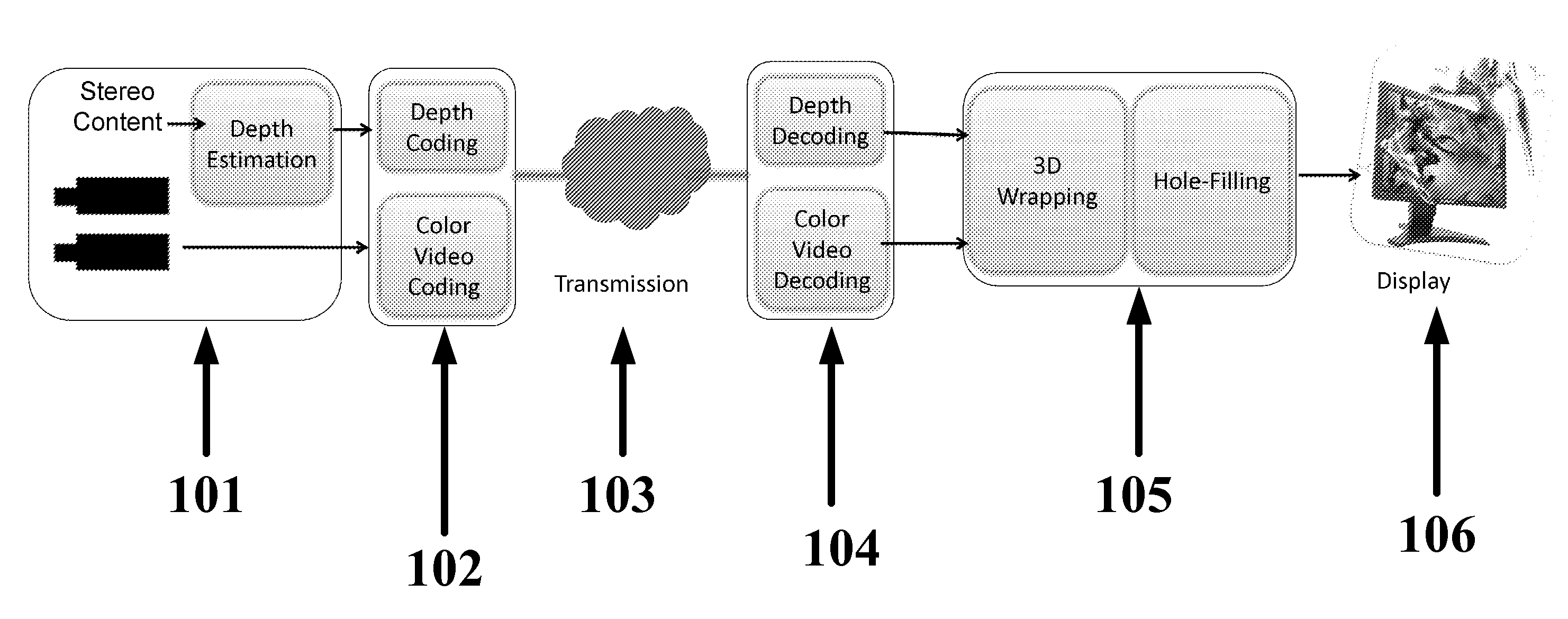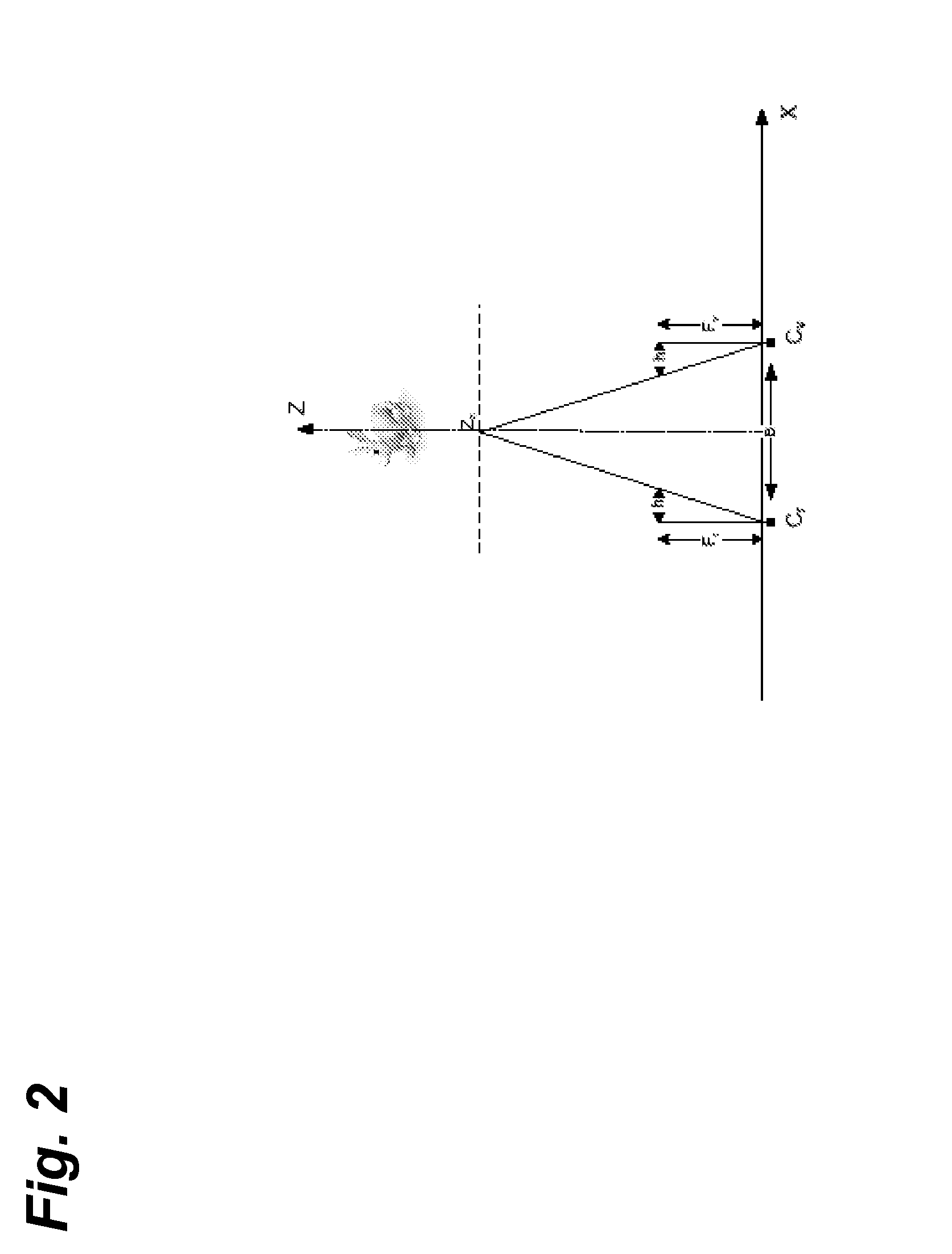Hierarchical hole-filling for depth-based view synthesis in ftv and 3D video
a technology of depth image and view synthesis, applied in the field of threedimensional images, can solve the problems of cumbersome and expensive ftv synthesis from multi-camera capture of a large number of views, requiring an unrealistically high number of cameras, and expensive processors
- Summary
- Abstract
- Description
- Claims
- Application Information
AI Technical Summary
Benefits of technology
Problems solved by technology
Method used
Image
Examples
example 1
[0102]FIG. 12 shows the comparison between Zhang's approach (FIG. 12a) and DIBR using HHF (FIG. 12b). The virtual image yielded by HHF in FIG. 12b has substantially no geometric distortions. To the contrary, with regard to FIG. 12a, the virtual image produced by Zhang's filtering approach has obvious geometric distortions and average filtering is needed to eliminate additional holes. Similarly, as shown in FIGS. 12d and 12f, HHF substantially eliminates disocclusion without substantial geometric distortion. Conversely, Zhang's filtering approach yields images with very noticeable geometric distortions and some disocclusion, as shown in FIGS. 12c and 12e.
[0103]Another advantage of HHF over depth map filtering is that HHF is less sensitive to poor depth map estimation. The results shown in FIGS. 12a-12f were all based on ground truth high accuracy depth maps. However, in practice, depth maps are often generated using a stereo matching algorithm. The estimat...
example 2
HHF and Depth Adaptive HHF vs. Depth Map Smoothing and Inpainting
[0106]FIG. 15 and FIG. 16 each show four synthesized views after applying depth adaptive HHF, Zhang's depth map symmetric filtering, and inpainting through Vazquez's horizontal interpolation, respectively.
[0107]FIGS. 15a and 16a show views synthesized by depth adaptive HHF, and FIGS. 15b and 16b show views synthesized by HHF. These images are of generally high quality, have sharp edges, and do not show substantial distortions. In FIG. 16, depth adaptive HHF (FIG. 16a) shows a clearer texture reconstruction than HHF (FIG. 16b).
[0108]FIGS. 15c and 16c show that, while Zhang's depth map smoothing appears to result in a clean image near the edges of objects, it causes severe geometric distortions. These distortions can be seen, for example, in the bottom-left of the pyramid in FIG. 15c and in the bowing of the leaf in FIG. 16c (the leaf in FIG. 16c is flatter than it is in the other images, indicating that it is geometrica...
example 3
PSNR Analysis of Stereoscopic Images
[0110]In another test, two views of several images were synthesized from a first view of each image. The holes in the synthesized views were then filled by applying depth adaptive HHF, HHF, Zhang's depth map filtering, and Vazquez's inpainting through horizontal interpolation.
[0111]The resulting views were evaluated by peak signal-to-noise ratio (“PSNR”), which is a measure of the quality of the reconstructed image, with higher output dB values denoting higher reconstruction quality. The resulting dB outputs are shown below:
DepthZhang'sVazquez'sAdaptiveDepth MapHorizontalHHFHHFSmoothingInterpolationAloe220.873420.864818.992719.1042Aloe021.022120.903618.898620.8023Art218.881118.873218.005818.8721Art018.212318.207717.778717.6509Books217.416317.327215.487415.2277Books017.736717.70117.236217.373Monopoly221.082520.982517.22320.1216Monoploy020.863520.981516.811719.7395
[0112]From the results it is clear that depth adaptive HHF has a significant advantage...
PUM
 Login to View More
Login to View More Abstract
Description
Claims
Application Information
 Login to View More
Login to View More - R&D
- Intellectual Property
- Life Sciences
- Materials
- Tech Scout
- Unparalleled Data Quality
- Higher Quality Content
- 60% Fewer Hallucinations
Browse by: Latest US Patents, China's latest patents, Technical Efficacy Thesaurus, Application Domain, Technology Topic, Popular Technical Reports.
© 2025 PatSnap. All rights reserved.Legal|Privacy policy|Modern Slavery Act Transparency Statement|Sitemap|About US| Contact US: help@patsnap.com



